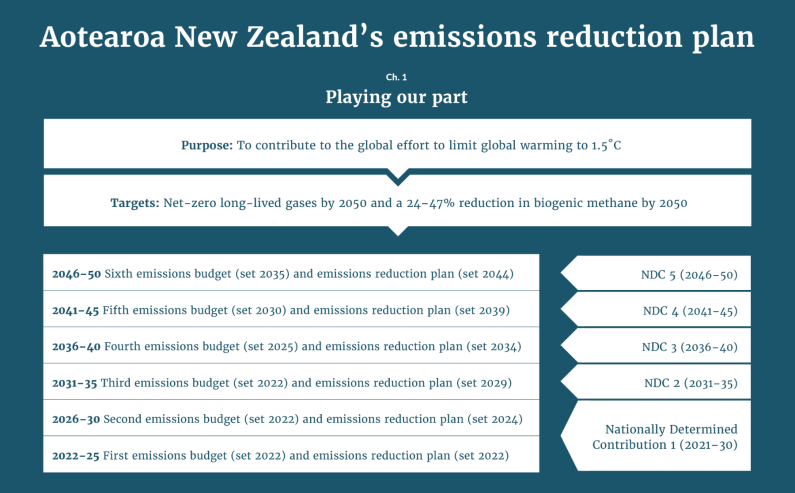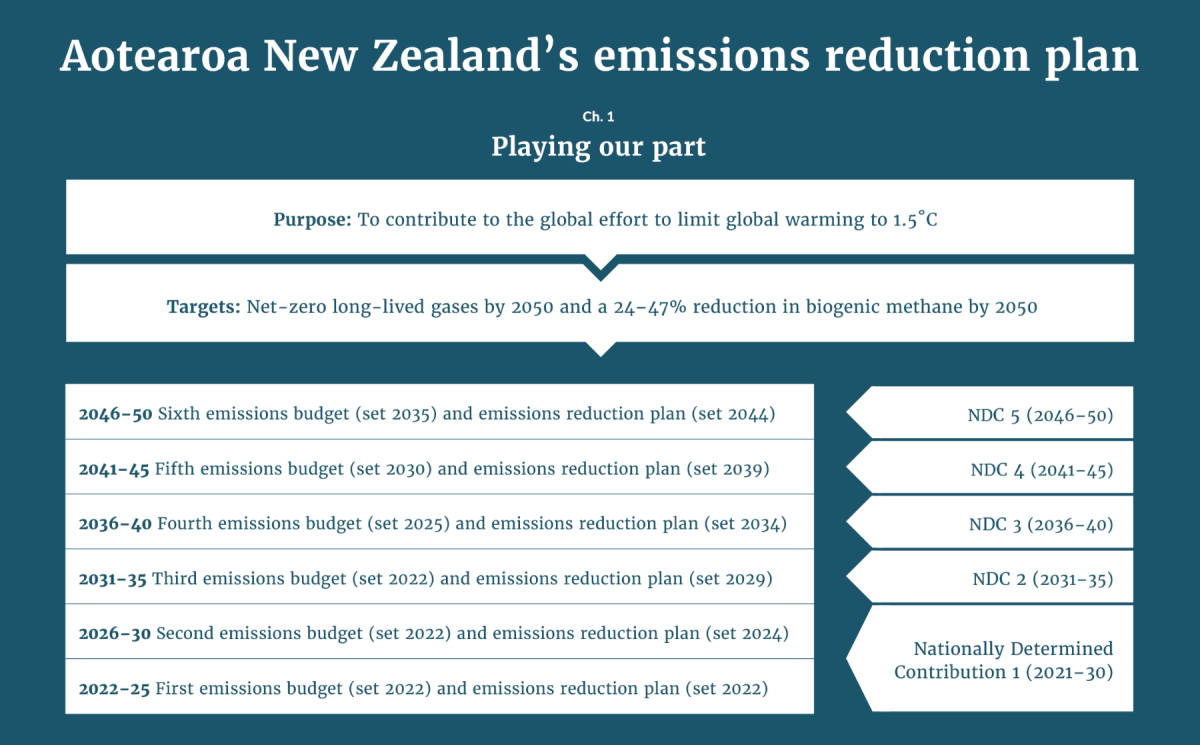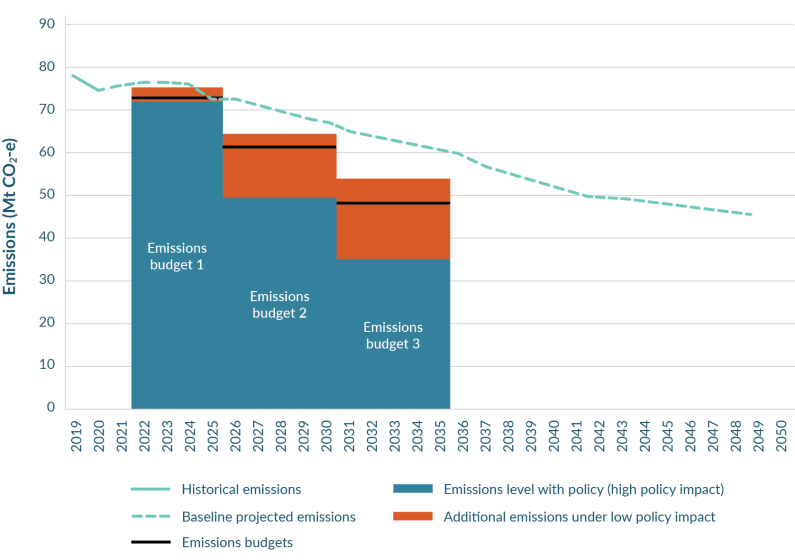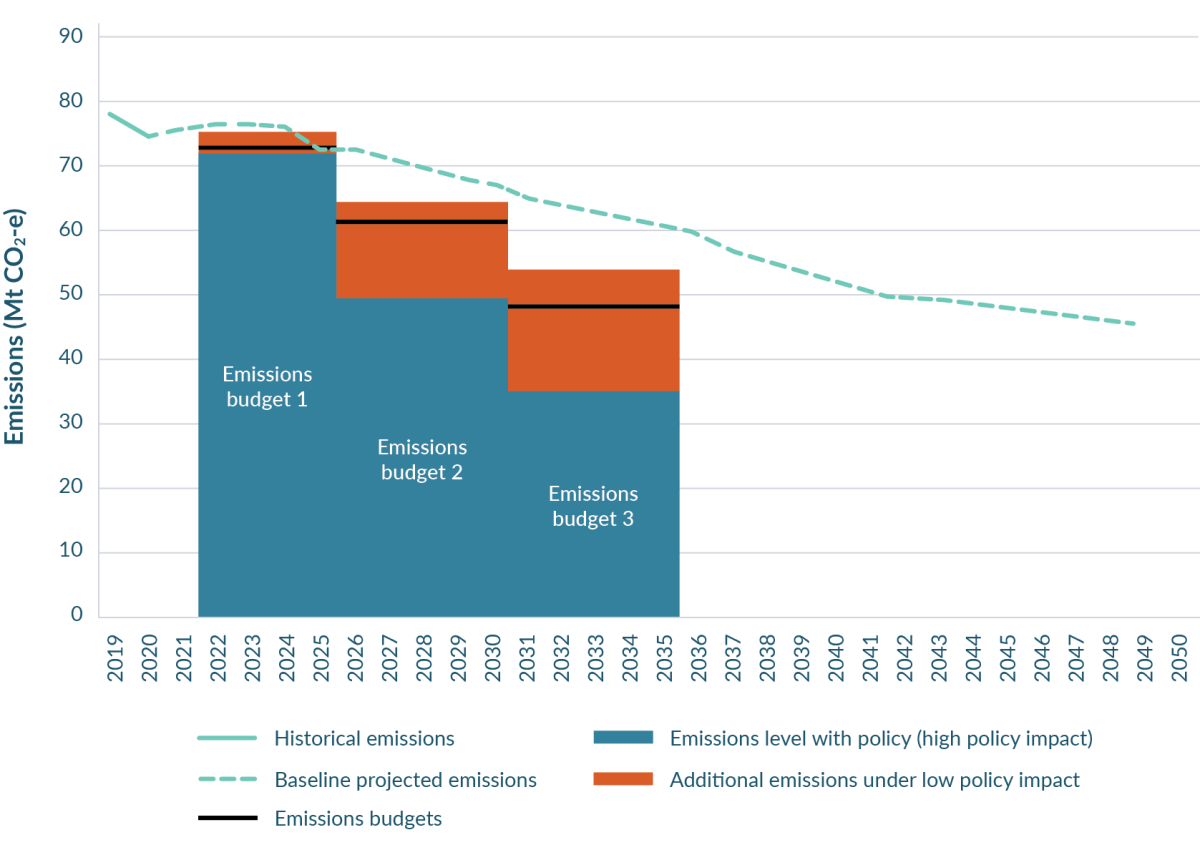Chapter 1 Playing our part

Download a PDF version of this chapter [PDF, 656 KB]
This chapter sets out the strategic framework for how we will reduce emissions across Aotearoa New Zealand, while improving sectors’ ability to adapt to the effects of climate change.
This chapter outlines:

Purpose: To contribute to the global effort to limit global warming to 1.5˚C
Targets: Net-zero long-lived gases by 2050 and a 24–47% reduction in biogenic methane by 2050
| 2046–50 Sixth emissions budget (set 2035) and emissions reduction plan (set 2044) | NDC 5 (2046–50) |
| 2041–45 Fifth emissions budget (set 2030) and emissions reduction plan (set 2039) | NDC 4 (2041–45) |
| 2036–40 Fourth emissions budget (set 2025) and emissions reduction plan (set 2034) | NDC 3 (2036–40) |
| 2031–35 Third emissions budget (set 2022) and emissions reduction plan (set 2029) | NDC 2 (2031–35) |
| 2026–30 Second emissions budget (set 2022) and emissions reduction plan (set 2024) | Nationally Determined Contribution 1 (2021–30) |
| 2022–25 First emissions budget (set 2022) and emissions reduction plan (set 2022) |

Purpose: To contribute to the global effort to limit global warming to 1.5˚C
Targets: Net-zero long-lived gases by 2050 and a 24–47% reduction in biogenic methane by 2050
| 2046–50 Sixth emissions budget (set 2035) and emissions reduction plan (set 2044) | NDC 5 (2046–50) |
| 2041–45 Fifth emissions budget (set 2030) and emissions reduction plan (set 2039) | NDC 4 (2041–45) |
| 2036–40 Fourth emissions budget (set 2025) and emissions reduction plan (set 2034) | NDC 3 (2036–40) |
| 2031–35 Third emissions budget (set 2022) and emissions reduction plan (set 2029) | NDC 2 (2031–35) |
| 2026–30 Second emissions budget (set 2022) and emissions reduction plan (set 2024) | Nationally Determined Contribution 1 (2021–30) |
| 2022–25 First emissions budget (set 2022) and emissions reduction plan (set 2022) |
The purpose of this emissions reduction plan is to contribute to global efforts to limit temperature rise to 1.5˚C above pre-industrial levels.
The science (and increasingly our own experience of severe floods, droughts, fires and storms) tells us that taking action on climate change is of paramount urgency and utmost importance.
Aotearoa was one of the first countries in the world to refer to the goal of limiting global warming to 1.5˚C in primary legislation. This temperature goal drives our long-term targets, which are in turn broken down into a series of successive emissions budgets, or stepping stones, along the way.
The Climate Change Response Act 2002 also requires Aotearoa to prepare for, and adapt to, the effects of climate change. The actions we take to reduce
emissions can also help us build resilience to climate risk. Ensuring these actions do not increase our exposure to climate change means we are able to transition to a low-emissions and resilient economy.
It is critical that the world limits warming to 1.5˚C above pre-industrial levels.
Additional warming will increase the impacts of climate change. For example, increasing the severity and frequency of extreme heat events, the intensity of rainfall and the risk of drought.
As flooding, water scarcity and extreme weather events worsen, they will affect where we live, how we grow our food, and sustain our economy. Exceeding 1.5˚C increases the risk of long-lasting or irreversible impacts such as the loss of some ecosystems.
Limiting temperature rise to 1.5˚C will make it easier for ecosystems, food and health systems to adapt, and is likely to reduce the costs of adaptation. Globally, it is also likely to significantly reduce the number of people exposed to risks associated with sea-level rise and those exposed to water stress caused by climate change.*
* Compared with 2°C, limiting warming to 1.5°C is projected to protect up to 10 million people from risks associated with sea- level rise. Limiting warming to 1.5°C could reduce the proportion of the world population exposed to water stress induced by climate change by up to 50 per cent.
To drive our contribution to the global effort of limiting warming to 1.5˚C, Aotearoa adopted a series of domestic emissions reduction targets in legislation for the first time. The Climate Change Response Act 2002 requires:
The separate components reflect the different warming effects that greenhouse gases have on the atmosphere. This approach also acknowledges our emissions profile and will help to drive change across every sector of the economy.
Our long-term targets will be met through a series of interim targets, called emissions budgets. Emissions budgets specify the amount of greenhouse gas emissions that is permitted over a five-year period, or four years in the case of the first emissions budget. Emissions budgets will get smaller over time, helping Aotearoa to step progressively towards our 2050 target.
The first three emissions budgets for Aotearoa have been set by the Minister of Climate Change. These are considered both ambitious and achievable, given our starting point.
| First emissions budget (2022-25) | Second emissions budget (2026-30 |
Third emissions budget (2031-35) |
|
|---|---|---|---|
| All gases, net (AR5) | 290 | 305 | 240 |
| Annual average | 72.5 | 61.0 | 48.0 |
The first emissions budget is the same as that recommended by He Pou a Rangi – Climate Change Commission (the Commission).
The emissions budgets for 2026–30 and 2031–35 are lower than the emissions budgets recommended by the Commission (a reduction of 7 Mt CO2-e for the second emissions budget period and a reduction of 13 Mt CO2-e for the third emissions budget period).
Between the Commission providing its advice in May 2021 and the Minister of Climate Change setting the emissions budgets, new information became available that changed our forestry projections. Our adopted emissions budgets reflect the impact of the afforestation component of the new forestry projections.
Sub-targets* will help to track progress across key sectors over each emissions budget period, to make sure we are on track across the economy as a whole.
While sub-targets are a useful tool for checking progress, they are not intended to lock Aotearoa into a single pathway to meeting emissions budgets.
We know that technological developments and economic changes will occur as we move through each emissions budget period. The Government needs to be able to respond to these changes and seize any opportunities to reduce emissions faster or change focus, if required.
The Government will take an adaptive management approach, responding to these changes and seizing any opportunities to reduce emissions faster or change focus if required.
The Climate Change Chief Executives Board will be responsible for monitoring and reporting on overall progress towards the emissions budgets, including sector sub-targets. This will involve advising on how to adjust policy settings to manage variances within – and between – sector sub-targets to support meeting the overall emissions budgets.
* Unlike emissions budgets, the sector sub-targets are not legislated.
| Sector | First emissions budget (2022-25) | Second emissions budget (2026-30) | Third emissions budget (2031-35) | Relevant agency or agencies | Responsible Minister |
|---|---|---|---|---|---|
|
Transport |
65.9 | 76.0 | 56.8 | Ministry of Transport |
Minister of Transport |
| Energy and industry | 70.1 | 72.8 | 63.3 | Ministry of Business, Innovation and Employment |
Minister of Energy and Resources |
| Agriculture | 159.4 | 191.0 | 183.0 | Ministry for Primary Industries | Minister of Agricuture |
| Waste | 13.7 | 14.9 | 12.7 | Ministry for the Environment | Minister for the Environment |
| Fluorinated gases | 6.8 | 7.5 | 5.9 | Ministry for the Environment | Minister for the Environment |
| Forestry | - 26.4 | - 57.2 | - 81.6 | Ministry for Primary Industries | Minister of Forestry |
| Total | 290.0 | 305.0 | 240.0 | Climate Change Chief Executives Board | Prime Minister** |
Note: The sum of sector sub-target values differs from total emissions budgets due to rounding.
* These sub-targets include all greenhouse gases, reflect net (AR5), and are expressed in metric tons of carbon dioxide equivalent (Mt CO2-e). AR5 is the Fifth Assessment Report of the United Nations Intergovernmental Panel on Climate Change [IPCC], completed in 2014.
** The Prime Minister will oversee Ministerial progress against the sectors’ sub-targets. However, the Minister of Climate Change is responsible for meeting the emissions budgets under the Climate Change Response Act 2002.
Emissions reductions plans set out the policies and strategies for how we will meet our emissions budgets and – ultimately – our 2050 target.
These policies and strategies form a coherent, strategic package with a mutually supportive and balanced mix of emissions pricing, well-targeted regulation, tailored sectoral policies, direct investment (public and private), innovation and mechanisms that help nature thrive.
The mix of policy tools will change over time, responding and adapting to changing circumstances. No one policy tool is able to achieve the necessary reductions in a fair and equitable way. Different tools are needed as we build the foundations for meaningful change and emphasis shifts over time. For example, emissions pricing for agriculture is likely to increase as the industry builds the capability and technologies needed to reduce emissions.
This plan also sets out how we can use the transition to address long-standing issues, such as inequality and poor productivity, reduce living costs, and seize the economic opportunities of the transition.
Local government is fundamental to meeting our 2050 targets, mitigating the impacts of climate change and helping communities to adapt to climate change.
Local government makes decisions in many sectors that will need to transition. Councils provide local infrastructure and public services, such as roading and transport, three waters, kerbside collections and waste management, building consenting and compliance, and flood and coastal hazard management. They also have planning and decision-making powers in relation to land use and urban form.
Many councils are already working on initiatives to address the impacts of climate change and support an equitable transition. Councils play an important role in engaging with their communities to help with the significant behavioural shifts required to meet our climate goals.
Some councils have well-developed targets and emissions reductions plans in place and options for funding and financing. However, many do not have the capacity, capability or funding to effectively plan for and implement the action required.
Local government will need support and guidance from central government to build capacity and capability, understand their roles and responsibilities for emissions reduction and ensure they have the tools and resources needed for change, particularly in the first two emission budget periods.
Central and local government will work in partnership, alongside Māori, to align policies and deliver actions to meet our 2050 targets.
The first emissions budget requires Aotearoa to make sustained cuts in our gross emissions, as well as storing carbon through forestry. Making emissions cuts early will mean lower costs in the long run, lower cumulative emissions and less need for carbon offsets. It means taking responsibility now and leaving a better legacy for future generations.
Meeting the first emissions budget of 290 Mt CO2-e for 2022–25 is currently estimated to require an additional reduction of 11.5 Mt CO2-e, compared with how emissions are tracking. Baseline projected emissions are already tracking down under current policy settings.* The additional emissions reductions needed to meet the first emissions budget amount to around a further 4 per cent reduction.
In the first emissions budget period, it is likely that the most significant emissions reductions will be in the energy and industry sector and the transport sector. However, every sector will have a role to play and – in many cases – actions taken now will ensure success in future budget periods.
The policies and strategies that will lead to these reductions in the transport, energy and industry, building and construction, agriculture, forestry, waste and fluorinated gases sectors are detailed in the dedicated chapters below.
* This figure is based on the difference between the emissions budget and projected greenhouse gas emissions if we assume that the Tiwai Point Aluminium Smelter remains open. It is based on existing climate change policies and does not include the new actions included in the emissions reduction plan.
Figure 1.2 shows the cumulative impact of emissions reduction plan policies relative to the first three emissions budgets and current baseline projected emissions.


Adapting to the effects of climate change is integral to achieving a low-emissions and climate-resilient economy. The impacts of climate change are already being felt by New Zealanders. We need to adapt to climate impacts already locked in, while proactively building resilience and adapting to future risk. To ensure a joined-up climate response, it is essential that, in transitioning to a low-emissions future, we also build resilience and decrease our exposure to climate risk.
The first national adaptation plan will be published in 2022. It is a government-led plan that will address climate risks over the next six years and is the first step in a long-term adaptation strategy and process.
The long-term adaptation strategy and process is built on three goals. These align with the global goal established under the Paris Agreement, which aims to enhance adaptive capacity, strengthen resilience and reduce vulnerability to climate change.
The draft national adaptation plan has three focus areas. These focus areas may be subject to refinement as the national adaptation plan is finalised.
These focus areas will set the foundation for adaptation action. Focus areas two and three will also help improve the ability of sectors to adapt by enabling them to assess and reduce their own climate risks, and by embedding consideration of risk in all government strategies and proposals.
Each sector chapter has identified areas where action can be taken that aligns with the global adaptation goal. Here are two examples.
Some system settings chapters span multiple sectors and identify actions that have both mitigation and adaptation co-benefits.
For example, chapter 7: Planning and infrastructure outlines how resource management reform can support long-term strategic planning of urban and rural areas with a lower emissions profile and reduced significant risks from natural hazards.
Under the Paris Agreement, Aotearoa New Zealand has set a Nationally Determined Contribution (NDC) [PDF, 6.5 MB] of reducing net emissions by 50 per cent below gross 2005 levels for the period 2021–30. This represents our highest possible ambition for contributing to the global effort.
To meet our NDC, Aotearoa will prioritise domestic action by reducing gross emissions and increasing removals from forestry. The measures outlined in this emissions reduction plan will be complemented by cooperation to reduce emissions in other countries.
Working with partners will help us achieve our NDC and enable emissions reductions in other countries. By enabling us to look beyond the emissions reductions that we can achieve within Aotearoa, working with others allows us to make a more significant contribution to global efforts to limit temperature rise to 1.5˚C.
Emissions reductions we support in other countries will have strong standards of environmental integrity, respect human rights and the rights of indigenous peoples.
Aotearoa will report on the implementation and achievement of our NDC through the Paris Agreements’ Enhanced Transparency Framework. Our next NDC – for the period 2031–35 – will be communicated in 2025.
Aotearoa has responsibilities under the Paris Agreement to support developing countries’ mitigation and adaptation efforts. Support includes climate finance, capacity building and technology transfer.
Aotearoa has pledged NZ$1.3 billion in climate finance over 2022–25. Of this finance, at least half will go to the Pacific and at least half will be spent on adaptation action. A climate finance strategy is being developed to guide decisions on how finance will be delivered from 2022–25.
International cooperation allows us to access – and share – innovation, investment, ideas, technologies and products that will help us transition to a low-emissions future. Our advanced and open economy creates opportunities to cooperate with others (public and private) to accelerate solutions and seize opportunities.
We currently achieve this cooperation in a number of ways, including through the United Nations, World Trade Organization and other multilateral negotiation bodies, as well as through plurilateral and bilateral initiatives. This includes participating in global research initiatives (including the Global Research Alliance on Agricultural Greenhouse Gases) and holding dialogue with partners on policy, best practice and technology.
Aotearoa also seeks mutually beneficial trade and climate outcomes by cooperating with other countries through trade policy and agreements, in line with the Ministry of Foreign Affairs and Trade’s Trade For All Agenda. For example, Aotearoa is looking to conclude the Agreement on Climate Change, Trade and Sustainability (ACCTS).* This will be a plurilateral trade agreement that brings together trade, climate change and sustainability agendas.** We also advocate for the reform of environmentally harmful subsidies (for example, fossil fuel subsidies).
*The ACCTS will initially be made between Costa Rica, Fiji, Iceland, New Zealand, Norway and Switzerland. Once concluded, other countries may join.
** For example, by removing tariffs on environmental goods, establishing new and binding commitments for environmental services, establishing disciplines to eliminate harmful fossil fuel subsidies, and establishing guidelines to inform the development and implementation of voluntary eco-labelling programmes and associated mechanisms to encourage their promotion and application.

Chapter 1 Playing our part
May 2022
© Ministry for the Environment